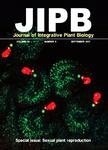Graft-accelerated virus-induced gene silencing facilitates functional genomics in rose flowers
Graft-accelerated virus-induced gene silencing facilitates functional genomics in rose flowers作者机构:Flower Research Institute of Yunnan Academy of Agricultural Sciences 650205 Kunming China Beijing Key Laboratory of Development and Quality Control of Ornamental Crops Department of Ornamental Horticulture China AgriculturalUniversity 100193 Beijing China
出 版 物:《Journal of Integrative Plant Biology》 (植物学报(英文版))
年 卷 期:2018年第60卷第1期
页 面:34-44页
核心收录:
学科分类:0710[理学-生物学] 07[理学] 09[农学]
基 金:supported by the National Natural Science Foundation of China (31501791, 31660579, and 31360492) Leading talents in science and technology (2016HA005) funded in part by Beijing Natural Science Foundation (6162017)
主 题:TRV Graft-accelerated virus-induced gene silencing facilitates functional genomics in rose flowers Figure DFR
摘 要:Rose has emerged as a model ornamental plant for studies of flower development, senescence, and morphology, as well as the metabolism of floral fragrances and ***-induced gene silencing(VIGS) has long been used in functional genomics studies of rose by vacuum infiltration of cuttings or seedlings with an Agrobacterium suspension carrying TRV-derived vectors. However, VIGS in rose flowers remains a challenge because of its low efficiency and long time to establish silencing. Here we present a novel and rapid VIGS method that can be used to analyze gene function in rose,called ‘graft-accelerated VIGS’, where axil ary sprouts are cut from the rose plant and vacuum infiltrated with Agrobacterium. The inoculated scions are then grafted back onto the plants to flower and silencing phenotypes can be observed within 5 weeks, post-infiltration. Using this new method, we successfully silenced expression of the RhDFR, RhA G, and RhNUDXin rose flowers, and affected their color, petal number, as well as fragrance, respectively. This grafting method will facilitate high-throughput functional analysis of genes in rose flowers. Importantly, it may also be applied to other woody species that are not currently amenable to VIGS by conventional leaf or plantlet/seedling infiltration methods.



